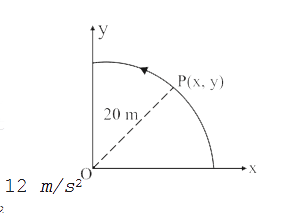A point object moves on a circular path such that distance covered by it is given by function meter ( t in second). The ratio of the magnitude of acceleration at . is then the radius of the circle is
1 m
3 m
The correct Answer is:B
To solve the problem, we need to find the radius of the circular path of a point object moving along it, given the distance function S(t)=t22+2t and the ratio of the magnitudes of acceleration at t=2s and t=5s is 1:2.
Step 1: Find the velocity function
The velocity v(t) is the first derivative of the displacement function S(t).
v(t)=dSdt=ddt(t22+2t)=t+2
Step 2: Find the tangential acceleration
The tangential acceleration at is the derivative of the velocity function.
at=dvdt=ddt(t+2)=1m/s2
Step 3: Find the centripetal acceleration at t=2s and t=5s
The centripetal acceleration ac is given by the formula ac=v2r.
1. At t=2s:
v(2)=2+2=4m/s
ac(2)=v(2)2r=42r=16r
2. At t=5s:
v(5)=5+2=7m/s
ac(5)=v(5)2r=72r=49r
Step 4: Find the total acceleration at t=2s and t=5s
The total acceleration a is the vector sum of the tangential and centripetal accelerations.
1. At t=2s:
a(2)=√ac(2)2+a2t=√(16r)2+12=√256r2+1
2. At t=5s:
a(5)=√ac(5)2+a2t=√(49r)2+12=√2401r2+1
Step 5: Set up the ratio of the accelerations
Given that the ratio of the magnitudes of acceleration at t=2s and t=5s is 1:2:
a(2)a(5)=12
Substituting the expressions for a(2) and a(5):
√256r2+1√2401r2+1=12
Step 6: Square both sides and cross-multiply
256r2+1=14(2401r2+1)
Multiplying both sides by 4r2:
4(256+r2)=2401+r2
Step 7: Simplify and solve for r2
1024+4r2=2401+r2
3r2=1377
r2=13773
Step 8: Find r
r=√13773=√1377√3=√51×27√3=3√51
Final Answer
The radius of the circle is 3√51meters.
---
The velocity v(t) is the first derivative of the displacement function S(t).
The tangential acceleration at is the derivative of the velocity function.
The centripetal acceleration ac is given by the formula ac=v2r.
v(2)=2+2=4m/s
ac(2)=v(2)2r=42r=16r
v(5)=5+2=7m/s
ac(5)=v(5)2r=72r=49r
The total acceleration a is the vector sum of the tangential and centripetal accelerations.
a(2)=√ac(2)2+a2t=√(16r)2+12=√256r2+1
a(5)=√ac(5)2+a2t=√(49r)2+12=√2401r2+1
Given that the ratio of the magnitudes of acceleration at t=2s and t=5s is 1:2:
256r2+1=14(2401r2+1)
1024+4r2=2401+r2
3r2=1377
r2=13773
r=√13773=√1377√3=√51×27√3=3√51
The radius of the circle is 3√51meters.
Similar Questions
A particle moves in a circle of radius 20 cm. Its linear speed is given by v=(3t2+5t) where t is in second and v is in m/s. Find the resultant acceleration at t = 1s.
View SolutionThe velocity of a particle is given by v=(2t2−4t+3)m/s where t is time in seconds. Find its acceleration at t=2 second.
View SolutionMotion of particle is given by equation
s=(5t3+3t2+8t+17)m
The value of acceleration of the particle at t = 2 s is
View SolutionThe distance covered by an object (in meter) is given by
s=8t3−7t2+5t
Find its speed at t = 2 s.
View SolutionA particle moves along a straight line such that its displacement at any time t is given by s=3t3+7t2+14t+5. The acceleration of the particle at t=1s is
View SolutionIf v=(t2−4t+105)m/s where t is in second. Find acceleration at t=1 sec.
View SolutionA particle moves in a circle of radius 30cm. Its linear speed is given by v=2t, where t in second and v in m/s. Find out its radial and tangential acceleration at t=3s.
View SolutionA particle moves in a circle of radius 2cm at a speed given by v=4t, where v is in cms−1 and t is in seconds.
(a) Find the tangential acceleration at t=1s
(b) Find total acceleration at t=1s.
View SolutionA particle moves in a circle of radius 20 cm. Its linear speed is given by v=2t, where t is in second and v in metre/ second. Find the radial and tangential acceleration at t=3s.
View SolutionA point P moves in counter-clockwise direction on a circular path as shown in the figure. The movement of 'P ' is such that it sweeps out a length s=t3+5 where s is in meters and t is in seconds. The radius of the path is 20 m. The acceleration of ' P ' when t = 2 s is nearly:

View Solution
